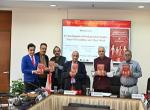Vivekananda International Foundation organized a virtual meeting on 11 April 2022 in the episode of the Strategic Discussion Series with the theme "Development in Sri Lanka and its implementation".
The welcome address was given by Lt General R K Sawhney. During this discussion, keynote speakers were Mr Nitin Gokhale, Amb. Ashok Kantha, Mr PM Heblikar, Akshay Mathur and a few other speakers were present.
The seeds of the economic plight of present Sri Lanka were being sown long ago. For example, in 2006, Sri Lanka continued to increase military investment to deal with its civil war, as well as investment in Sri Lanka was negligible due to its adverse economic policies. As a result, the debt to GDP ratio reached about 91% in 2006. The government of Sri Lanka suppressed the civil war in 2009. With this, a new chapter of development started in Sri Lanka, the results of which were to be seen soon. There was a massive boom in the tourism sector and investment from other countries in Sri Lanka increased. Due to this, the debt to GDP ratio fell to 71% in 2014.
In 2019, after the 'Rajapaksa family' came to power, they reduced the value-added tax from 15% to 8% and completely abolished the nation-building tax, which was 2%. As a result, this government policy led to a tremendous increase in inflation in the country and saw a considerable cut in the government's income. On 21 April 2019, on the occasion of Easter Sunday in Sri Lanka, serial bomb blasts took place. Due to these terrorist attacks, Sri Lanka's tourism industry suffered a setback. Later on, the international travel restrictions imposed due to Covid-19 caused much damage to the economy of Sri Lanka. It was at this point that the tourism industry collapsed completely, and a large number of people dependent on the tourism industry started migrating to the rural areas of Sri Lanka.
Today Sri Lanka is battling a man-made disaster. The Government of Sri Lanka set the 100% organic farming target in October 2021. To achieve this, the government banned the chemical fertilizers import from abroad altogether. Within a short time, Sri Lanka's agriculture declined more than 40%, with the food crisis arising, and tea and rubber exports being severely affected. The current state of Sri Lanka's economy has become like that of a multi-organ failure patient. The Central Bank of Sri Lanka has only $2 billion in forex reserves left, and Sri Lanka has to pay off the loan of about $7 billion in FY 2022. The situation in Sri Lanka is so dire that inflation has exceeded 17%, and food inflation has exceeded 24%. Sri Lanka's sovereign bonds have been rated CCC by almost all credit rating agencies, which is a junk category bond.
On the other hand, there are severe allegations of nepotism and corruption against the present government. Prime Minister Mahendra Rajapakse, Minister of Irrigation Chamal Rajapaksa, Minister of Finance Basil Rajapaksa, Minister of Youth and Sports Namal Rajapaksa, Chief of Staff to the Prime Minister Yoshitha Rajapaksa and President Gotabaya Rajapaksa come from the same family. Presently these ministers have resigned due to public outrage. Finance Minister Basil Rajapaksa is an American citizen. The Rajapaksa government even amended the Constitution to bring Basil to power.
Sri Lanka is India's neighbouring nation, and India is working closely with Sri Lanka; it is the best time for India to balance China’s influence in Sri Lanka. India is making every effort to deal with this economic crisis. India has provided a line of credit of about $ 2.5 billion to Sri Lanka, out of which one billion dollars has been given only for the import of food grains and medicine, and a $ 500 million line of credit has been given for the import of fuel.
In August last year, using the SAARC Currency Swap Framework 2019, India signed a currency swap agreement worth $400 million with Sri Lanka. Through this agreement, the Central Bank of Sri Lanka can take US Dollars, Euros or Indian Rupees worth $400 million from India's central bank, RBI. Along with this, the export of rice, medicine, fertilizer and other essential items is being done continuously.






Post new comment